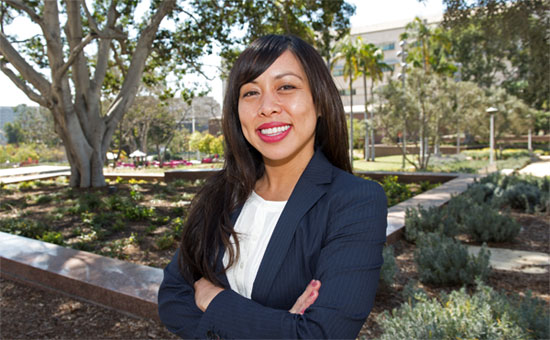
Stella Fogleman is helping to lead the county’s efforts to prepare for and cope with disasters.
When Monday’s 4.4 earthquake struck Los Angeles, Stella Fogleman reacted like many parents—quickly stretching her arms over her two young children who had crawled into bed with her.
“I was like mama chicken with my wings,” Fogleman laughs.
Those wings stretch further than most. The 37-year-old was recently promoted to the position of interim director of the L.A. County Department of Public Health’s Emergency Preparedness and Response program.
She says that Monday’s 6:25 a.m. temblor—which shook people awake but didn’t cause serious damage—was a nice boost to her mission of getting people ready for a more serious disaster. Fogleman says her instinct to protect herself and those in her immediate area was the right one.
“It’s like the oxygen mask falling on an airplane,” she says. “You have to help yourself first, that way you will be able to help your community.”
Caring for communities has long been part of Fogleman’s job description. She got her start with the department in 2001 as a public health nurse, armed with master’s degrees in public health and nursing. Most of her time was spent monitoring tuberculosis cases to enforce strict protocols aimed at preventing the spread of the disease. From there, she moved to “toxics epidemiology,” shifting focus to diseases that result from toxic exposure.
Most recently, Fogleman led the development and implementation of the Community Disaster Resilience project—an alliance between the department, individual communities and emergency response agencies. The program uses public health department facilitators to educate community organizers on how to effectively prepare, respond and share knowledge. Fogleman hopes to keep that ball rolling in her new role.
“The key is collaboration,” she says. “You’re never as good by yourself as you are with others. Together, you have a broader set of resources.”
With only a few rumbles since the Northridge quake 20 years ago, Fogleman says it’s human nature to become complacent. But lack of preparation threatens to leave the region flat-footed when the next disaster strikes. According to public health studies, less than 20% of L.A. County households currently have earthquake kits. (The department’s website has a comprehensive checklist of what to include when creating your kit.)
But if fully stocking up seems a bit intimidating, Fogleman says a good first step would be to talk to neighbors about disaster strategies. Then, she says, you can begin to prepare and plan together.
It’s also important to secure homes by tethering tall furniture and securing books and glasses that could fly from shelves and cupboards, Fogleman says. People should know how to shut off gas and water in case of leaks, and families should go room-to-room to identify “safe places” to duck, cover and hang on—away from windows and under the cover of a sturdy table or desk, if possible. “That way you will subconsciously go to that spot,” Fogleman said.
Having the right supplies on hand can be a crucial. In the case of a widespread disaster, infrastructure may be damaged, cutting people off from the rest of the world. When an emergency response is spread over a large area, help might not come for days or even as long as two weeks, Fogleman says. Knowing first aid and CPR can help save lives if anyone is seriously injured.
As time goes on, people usually want to communicate with friends and family who live elsewhere. Having multiple ways of doing that—cell phones, internet and land lines—improves your chances of being heard. Fogleman says people can visit the Red Cross’s website to list themselves as “Safe and Well” so out-of-towners know they’re okay.
For those who want to go the extra mile, Fogleman recommends bereadyla.org, which has tools for preparing and community organizing. The Los Angeles County Sheriff’s Department provides Community Emergency Response Team training on how to respond to all kinds of disasters.
In the event of a damaging earthquake, the Department of Public Health would work in the background while first responders tackle the situation in the streets, Fogleman says. It’s her department’s responsibility to minimize a disaster’s impact over time, addressing such things as food-borne illnesses and checking buildings for safety. “If we’re doing our job well, no one hears about us,” she says.
However, that’s something she hopes to change by highlighting the positive things the department does to help people during an emergency. She wants to improve her program’s outreach by increasing the number of its publications and creating a newsletter. Getting the word out is one of the cheapest—and most effective—ways of preparing people for the worst, Fogleman says.
Despite the serious nature of her job, Fogleman approaches things with a positive attitude that comes, she says, from a genuine love of public service.
“There’s no question that what I do every day helps people,” she says. “There’s a real satisfaction with that.”
Posted 3/20/14






